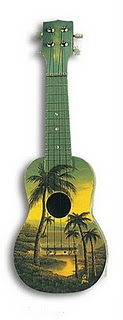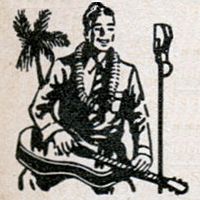 Jerry Byrd (1920-2005) was a brilliant steel guitar artist who set the
standard for generations to come. Jerry invented the C6th tuning (Jerry
says it was at least 1938 on page 119 of his autobiography). He also
invented the C Diatonic tuning later on in 1952, which few steel guitar
enthusiasts are familiar with. Jerry didn't fully develop the tuning until
much later on, but he sure made some awesome recordings with it in the
1950's and 1960's. To show you what can be done with the Diatonic tuning,
check out this 1955 recording by Jerry Byrd titled, “Come
A Little Closer” (from his Hi-Fi Guitar album). Here's
some tabs for the song!
Jerry Byrd (1920-2005) was a brilliant steel guitar artist who set the
standard for generations to come. Jerry invented the C6th tuning (Jerry
says it was at least 1938 on page 119 of his autobiography). He also
invented the C Diatonic tuning later on in 1952, which few steel guitar
enthusiasts are familiar with. Jerry didn't fully develop the tuning until
much later on, but he sure made some awesome recordings with it in the
1950's and 1960's. To show you what can be done with the Diatonic tuning,
check out this 1955 recording by Jerry Byrd titled, “Come
A Little Closer” (from his Hi-Fi Guitar album). Here's
some tabs for the song!The Diatonic tuning is extremely simple to
remember, just follow the alphabet for the bottom seven strings (from bass
to treble: D, E, F, G, A, B, C, E). Using this very tuning (minus the
bottom “D” note because Jerry's steel guitar only had 7-strings), he
recording on the song, “Next
To Jimmy” (here's the MP3) by Ferlin Husky,
recorded in 1960. Wow! Great stuff!
I've made a humble attempt to tab out the
solo for others to learn. I have no idea if this is all correct, but it's
in the ballpark, and I think pretty close. I listened recently to the
recording and realized that I tabbed it wrong originally in 2015. The
fictional character Sherlock Holmes is famous for the quote, “Once you
eliminate the impossible, whatever remains, no matter how improbable, must
be the truth.” The only way that I've been able to imitate what Jerry did
is to lower the F (6th string) to a D# instead. That's a whole tone drop.
I've put an asterisk (*) sign by the chord below so you can see what I
mean.
Also, I believe Jerry's playing through his
old Volutone amplifier, which is more resemblant of a loudspeaker. You can
hear the distortion in his speaker. I just cranked up the gain on my
little Roland MobileCube amplifier to get a similar tone.
Jerry uses some great
manipulation of the bar in this song on strings 1 and 2, which requires some quick hand
skills and coordination. He's moving quickly at the beginning, which
creates almost an illusion to the ears. Jerry mastered this technique
better than anyone in my opinion. It's interesting how each steel
guitar tuning feels different the way you create the chords and sounds. I
think the C Diatonic has a pretty good feel
to it, not as laidback as the C6th, but offers some great sounds if you
master the techniques. Again, please be aware that I changed the standard
Diatonic tuning, lowering string 6 from an F note to a D# for this
particular song...
E_________________~20___20___18___~18_____16__15__14____~13_________________
C____15~14_15_____~20___________________________________~13_________________
B_______________________20___18___~18_______________________________________
A____15~14_15_____________________________15__15__15________________________
G_________________~20___20___18___~18___________________~13_________________
D#__________________________________________________________________________
E___________________________________________________________________________
E___13~~~~~8_____________________________13___~16___15~16~15___13___________
C___13~~~~~8_____~*11__*10____8___~13____13___~17___15~17~15___13___________
B___________________________________________________________________________
A________________~*11__*10____8___~13_______________________________________
G___13~~~~~7________________________________________________________________
D#_______________~*11__*10 (I lowered F to D# only for this song)___________
E___________________________________________________________________________
E______________________13______15___~18__16__16__16~15______________________
C___13~12~11~10___~13_____~15____________________________17~16___15_________
B___________________________________________________________________________
A___13~12~11~10___~13_____~15________________15__15~~~___15______15_________
G___________________________________________________________________________
D#__________________________________________________________________________
E___________________________________________________________________________
E___________________________________________________________________________
C___________________________________________________________________________
B___________________________________________________________________________
A___________________________________________________________________________
G___________________________________________________________________________
D#__________________________________________________________________________
E___________________________________________________________________________
Isn't that beautiful?
Scotty's Music in St. Louis has some nice solo tablature arrangements by
Jerry Byrd in his C Diatonic tuning, including the complete song, “Come
A Little Closer.” According to my order list, Scotty's also has Estrellita, Danny Boy,
Cold Cold Heart, Ebb Tide, Ame No Bojyo, Hana lei Moon, Honolulu Eyes,
Serenade To Nalani, Mauna Kea and Invitation To Love, tabbed out in the C
Diatonic tuning by Jerry.
What I like about the Diatonic tuning is that
the chords are there, unlike the Bill Leavitt
tuning where you have to work with less. I like the Leavitt Tuning, but
it is more difficult to work with. Jerry has impeccable bar slanting skills,
which when done accurately, quickly and with your amplifier cranked up, and
a decent guitar (this sounds like Jerry's 7-string Rickenbacher), it will
all sound GREAT. Don't be afraid to do quick reverse bar slants. In fact,
you should get into the habit of doing them as a practice scale. Jerry Byrd
masterfully glides through the scales, letting it all flow seamlessly.
That's all he's doing, following the melodic scales. It's not magic, just
plain ole hard work and persistence.
A helpful way to look at Jerry's Diatonic
tuning is that it is a C6th tuning with an added 9th (D note) and 11th (F
note). So you've really got a C11th tuning here. Really sweet too!

Let's use the chart above to see
what chords we've got in the C Diatonic tuning. I won't tab out all the
chords, because you can use the C6th chord
tabs here. You got the C6th tuning below with the added 3rd and 6th
string. So if you pretend that strings 3 and 6 aren't there, it the same as
standard C6th. This is a really versatile tuning, if not the most...
E_____C Major_________|__C minor__3___8___|__C9th__10_______5___|___C6th__0__12___
C____0___0___4___7____|___________3_______|________10__14_______|_________0__12___
B________0____________|___13__________8___|_________________5___|_________________
A____________3___7____|___________3_______|____________13___5___|_________0__12___
G____0________________|___12__________8___|________9________5___|_________0__12___
F________0___2___7____|___________________|_________________5___|_________________
E____0________________|___11______________|____________12_______|_________0__12___
D_____________________|___________________|_____________________|_________________
The nice thing about standard C6th is that you
can relax and just rake across all the strings; whereas with the C Diatonic
you've got to work at it more (like the Bill Leavitt tuning), but you've got
more to work with on the C Diatonic. It's a very beautiful and interesting
tuning to say the least!
Although this is not a strum tuning like the F#
minor 9th tuning, it does offer a very beautiful 9th chord as heard in the
previous song “Come
A Little Closer.” I tried to work out the solo for “Next To Jimmy” and it
requires some excellent left hand maneuvering for much of the solo, but
that's why Jerry was dubbed “The Master Of Touch And Tone” in the Steel
Guitar Hall of Fame. That's quite an honor, and Jerry earned it!
For the solo to “Next To Jimmy” you have to do
several bar slants, which aren't too difficult once you become familiar with
how the tuning works. Each tuning has a different “feel” to it, which once
you are comfortable with, you'll begin to excel at the tuning. I understand
the C6th well, so be viewing the C Diatonic tuning without strings 3 and 6,
I see why Jerry did what he did to invent this tuning. It is really an
expanded hybrid C6th. I think it's great!
The following helpful information is from
Jerry's good friend, Ray Montee...
By the 1960's, Jerry was using
his popular C-Diatonic tuning; one that he had been experimenting with since
1952 but simply had not had sufficient time to to explore fully.
His first commercial use of this new tuning was on Ferlin Husky's record of
“Next to Jimmy.” This tuning provided Jerry with a more “pedal-like” sound
which was more suitable for the days following Webb Pierce's “Slowly.”
The C-Diatonic tuning was more ideally suited for an eight string guitar but
Jerry eventually eliminated the “D” on the second string and ultimately
installed this tuning on his 7-string neck of the Sho-Bud.
Prior to having the Sho-Bud made for him, Jerry did use a 7-string Bakelite
with silver panels for quite some time but eventually he experienced
intolerable problems with the pickup so replaced it temporarily with a white
paneled, 7-string, post war model during 1949, that had the smaller 1 1/4"
pickups on it...
The original C-Diatonic:
E D C B A G F E D C (from high to
low)
- Jerry didn't use 10 strings, but this
is the logical extended tuning. Here is the specified 7-string tuning that
Jerry uses in all his C Diatonic tablature (from high to low): E C B A G F E
(no D note). I use an 8-string steel
guitar, so I added a D to the bottom for the 8th string [blue comments added
by me]
Jerry points out that this tuning
requires lot's of “muting” with the right hand; but, is quick to state that
its not actually necessary provided one knows how to slant the bar properly.
By the late 1970's, after Jerry had started using the double neck Sho-Bud in
Hawaii, his strings of preference became “Sho-Buds.”
Below are
Jerry's words regarding this song "Next to Jimmy" and his brilliant
newfound diatonic tuning. This was posted on This Forum in 2001 by
Jerry's brother, Jack Byrd. ...
Quote:
I experimented with various tunings in the years following my
discovery of C6th tuning in 1937 but all of them were “unplayable.”
Having gone to a 7-string guitar in the mid-40’s so I could add the
much needed “C” that was eliminated when I raised the 6th string to
C#, I then had C and C# to work with.
I kept “hearing” a chord in my head that I know would give me a new
dimension and after much twisting and turning of tuning keys and
changes of string gauges, I found it—this was sometime in the early
50’s. I ended up with the “alphabet” and the formula came out from
bottom to top as:
E-F-G-A-B-C (D)-E
I have the D in parenthesis because it completely made the whole
thing un-playable and was only in the way-and besides-I’d need an
8-string neck. So off it came - or should I say “out it went” and so
it ended up with “E to E without the D.” And my “lost chord was
there on the 6th, 5th, 4th, 3rd and 1st strings. And I still had my
E and C on top.
It took me a while to realize that I really had something! I could
do all I ever did in my C6th tuning and much more. It was great for
popular songs, because I could play most everything in 3 part
harmony with my ever-present “slants” and it was equally good for
Hawaiian and even country.
I kept it under wraps for 2 or 3 years which was easy because I was
about as much in demand as yesterdays newspaper---- but I kept
working with it. One day my phone rang and it was Ferlin Huskey.
“I’m doing a session soon and I want you to play steel”---I said –
“are you sure you called the right number??.” “Damn right!!” And I
want you to play “Jerry Byrd” and don’t let anybody try to change
anything.” I said – “well O.K.—I’ll be there.”
At the session he came over to me and said- “now I want you to play
Jerry Byrd on this next song- it’s titled Next to Jimmy.” I said
“give me a few minutes to see if I can remember what Jerry Byrd
did.” I then worked up the first recording I ever did in that
tuning. And it is still talked about. I am continually reminded of
it. Know what?? I have not the slightest idea of what I played. I’d
play and go home and forget about it. That’s the way we did it back
in our time.
Here is (in my humble
opinion) Jerry Byrd's finest album which he
recorded back in 1959. It is simply the most brilliant steel guitar
playing I have ever heard. I want to particularly draw your attention to
the song "Honolulu Eyes" which Jerry recorded using his amazing C
Diatonic tuning!
Hawaiian Beach Party
|
 Jerry Byrd (1920-2005) was a brilliant steel guitar artist who set the
standard for generations to come. Jerry invented the C6th tuning (Jerry
says it was at least 1938 on page 119 of his autobiography). He also
invented the C Diatonic tuning later on in 1952, which few steel guitar
enthusiasts are familiar with. Jerry didn't fully develop the tuning until
much later on, but he sure made some awesome recordings with it in the
1950's and 1960's. To show you what can be done with the Diatonic tuning,
check out this 1955 recording by Jerry Byrd titled, “Come
A Little Closer” (from his Hi-Fi Guitar album). Here's
some tabs for the song!
Jerry Byrd (1920-2005) was a brilliant steel guitar artist who set the
standard for generations to come. Jerry invented the C6th tuning (Jerry
says it was at least 1938 on page 119 of his autobiography). He also
invented the C Diatonic tuning later on in 1952, which few steel guitar
enthusiasts are familiar with. Jerry didn't fully develop the tuning until
much later on, but he sure made some awesome recordings with it in the
1950's and 1960's. To show you what can be done with the Diatonic tuning,
check out this 1955 recording by Jerry Byrd titled, “Come
A Little Closer” (from his Hi-Fi Guitar album). Here's
some tabs for the song!


